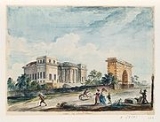
Hôtel Thellusson
Encyclopedia
).jpg)

Hôtel particulier
In French contexts an hôtel particulier is an urban "private house" of a grand sort. Whereas an ordinary maison was built as part of a row, sharing party walls with the houses on either side and directly fronting on a street, an hôtel particulier was often free-standing, and by the 18th century it...
, built in 1778 by Claude-Nicolas Ledoux for Marie-Jeanne Girardot de Vermenoux (1736–1781), widow of the banker from Geneva Georges-Tobie de Thellusson (1728–1776).
This hotel was situated at 30, rue de Provence
Rue de Provence
The rue de Provence is mainly in the IXe arrondissement of Paris. Only the short part of the street between rue du Havre and rue de Rome is in the VIIIe arrondissement....
, in an English garden
English garden
The English garden, also called English landscape park , is a style of Landscape garden which emerged in England in the early 18th century, and spread across Europe, replacing the more formal, symmetrical Garden à la française of the 17th century as the principal gardening style of Europe. The...
between the rue de Provence and the rue de la Victoire
Rue de la Victoire
The rue de la Victoire is a street in the IXe arrondissement of Paris.The former name of the street was "rue Chantereine" . The street took the name "rue de la Victoire" from 1797 to 1816 after the victorious campaign of Napoleon in Italy...
. It opened on the rue de Provence with a huge portal with the shape of a triumphal arch
Triumphal arch
A triumphal arch is a monumental structure in the shape of an archway with one or more arched passageways, often designed to span a road. In its simplest form a triumphal arch consists of two massive piers connected by an arch, crowned with a flat entablature or attic on which a statue might be...
, in antique Medicis style, in the axis of the rue Laffitte
Rue Laffitte
Rue Laffitte is a street in Paris' IXe arrondissement.This street was created in 1771 between the Boulevard des Italiens and the Rue de Provence. Its original name was Rue d'Artois, in honour of the Comte d'Artois, brother of the king Louis XVI, later king of France with the name of Charles X...
, at that time called the rue d'Artois. It was visible from the boulevard. Coaches entered the hôtel by a swept drive; there was also an exit in rue de la Victoire.
The central hall was also circular. In the center was a rock and around it a colonnade.
After her death in 1781, Mme Thelusson's eldest son, John Isaac de Thellusson Sorcy (1764–1828) completed the hotel. As they were Genevan nationals, the Thellusson kept ownership of the hotel during the Revolution
French Revolution
The French Revolution , sometimes distinguished as the 'Great French Revolution' , was a period of radical social and political upheaval in France and Europe. The absolute monarchy that had ruled France for centuries collapsed in three years...
, but they returned to it only in 1797.
After the Thermidorian Reaction
Thermidorian Reaction
The Thermidorian Reaction was a revolt in the French Revolution against the excesses of the Reign of Terror. It was triggered by a vote of the Committee of Public Safety to execute Maximilien Robespierre, Antoine Louis Léon de Saint-Just de Richebourg and several other leading members of the Terror...
, there was a bal des victimes
Bals des victimes
The Bals des victimes, or victims' balls, were balls that were said to have been put on by dancing societies after the Reign of Terror. To be admitted to these societies and balls, one had to be a near relative of someone who had been guillotined during the Terror...
, a "victims' ball" in the hotel. It was reserved for people with a close relative guillotined during the Revolution.
John Isaac sold the hotel in 1802 to the Prince Joachim Murat
Joachim Murat
Joachim-Napoléon Murat , Marshal of France and Grand Admiral or Admiral of France, 1st Prince Murat, was Grand Duke of Berg from 1806 to 1808 and then King of Naples from 1808 to 1815...
, who exchanged it in 1807 with Napoleon Bonaparte
Napoleon I
Napoleon Bonaparte was a French military and political leader during the latter stages of the French Revolution.As Napoleon I, he was Emperor of the French from 1804 to 1815...
for the Hôtel de l'Élysée (which will be renamed Élysée Palace
Élysée Palace
The Élysée Palace is the official residence of the President of the French Republic, containing his office, and is where the Council of Ministers meets. It is located near the Champs-Élysées in Paris....
) plus one million francs. Napoleon offered the house to Tsar Alexander Ist
Alexander I of Russia
Alexander I of Russia , served as Emperor of Russia from 23 March 1801 to 1 December 1825 and the first Russian King of Poland from 1815 to 1825. He was also the first Russian Grand Duke of Finland and Lithuania....
as the Russian Embassy in France. The tsar lived there in 1818, and Carlo Andrea Pozzo di Borgo
Carlo Andrea Pozzo di Borgo
Carlo Andrea, count Pozzo di Borgo , was a Corsican politician who became a Russian diplomat.He was born at Alata, near Ajaccio, of a noble Corsican family, four years before the island became a French possession...
, adviser of the tsar, organized prestigious balls and receptions in the hotel.
The house was destroyed in 1826 when the rue Laffitte was extended to the rue de la Victoire.

